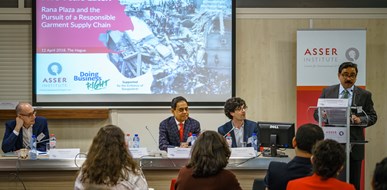Moving Forward Five Years after the Rana Plaza Collapse
Published 31 May 2018
The collapse of the Rana Plaza building on 24 April 2013 in Bangladesh, left at least 1,134 people dead and over 2,500 others wounded, while survivors and the families of the dead continue to suffer trauma in the aftermath of the disaster.
On 12 April, the eve of the fifth anniversary after the collapse, the Doing Business Right research team coordinated an event to appraise the legal and regulatory aftermath of the tragedy, including critical discussions of the innovations it triggered in the transnational regulation of the garment supply chain, processes intended to compensate victims, and, more generally, the various legal and non-legal initiatives that have emerged. The conference brought together key (trans)national policy-makers and civil society members involved in the aftermath of the Rana Plaza collapse. It was designed to serve as a platform for practitioners and academics to reflect on the steps taken to remedy the harm suffered by the victims of the Rana Plaza catastrophe and on the regulatory mechanisms introduced to ensure that it would never recur.
The discussion was divided into three panels, with each panel taking a broad theme. The first panel was dedicated to the victims: the injured and the families of those who died. It focused on the avenues available to hold individuals and companies legally accountable for the harm caused by the collapse. It was largely acknowledged that that many of the legal and "soft" avenues pursued have not dispensed any meaningful sense of justice, compensation for losses suffered or responsibility for the collapse, particularly as they have not brought the relevant garment industry actors – whether global or local – to account. While international solidarity in the form of the Rana Plaza Arrangement, has offered some (welcome and much-needed) financial compensation to the victims, this is a far cry from a full-fledged delineation of legal responsibility recognized in court.
The second panel discussed the transnational (public and private) regulatory responses to the tragedy addressing health and safety in the Bangladeshi garment industry and other aspects connected to the safety and security of factory workers in the garment value chain. The panel discussed and contrasted the various aims, structures and effects of responses including the Bangladesh Accord, the Alliance for Bangladesh Worker Safety and the Bangladeshi government-led National Tripartite Plan of Action on Fire Safety and Structural Integrity in the Garment Sector of Bangladesh. Many questions remain regarding their legitimacy, effectiveness and durability.
Finally, the last panel looked at the national responses to the tragedy in Bangladesh and in Europe in response to the collapse, exploring the potential of (soft and hard) regulatory developments to improve the fates of Bangladeshi workers in the garment industry. The discussion focused in particular on initiatives in France (Loi relative au devoir de vigilance des sociétés mères et des entreprises donneuses d’ordre) and the Netherlands (Dutch Agreement Agreement on Sustainable Garment and Textile). It was noted that these models of "regulating" corporations, whether mandatory or more voluntary in nature, are highly context-specific, and it remains to be seen how they will affect the fates of garment workers in the supply chain.
Listen to T.M.C. Asser Instituut's researchers Dr. Antoine Duval and Dr. Enrico Partiti share the highlights of the discussion and the key points discussed to keep moving forward and ensuring a crisis as such never happens again:
